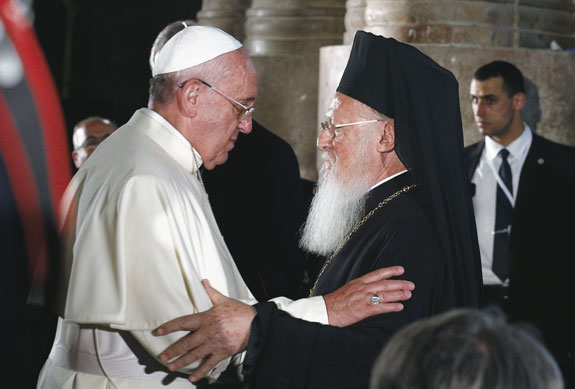by Francis X. Rocca
JERUSALEM (CNS) – Half a century after a historic encounter between their predecessors, Pope Francis and Ecumenical Patriarch Bartholomew met in the same place to seek inspiration for Christian unity at the site of Christ’s death and resurrection.
“We need to believe that, just as the stone before the tomb was cast aside, so, too, every obstacle to our full communion will also be removed,” the pope said May 25 during a prayer service at the Church of the Holy Sepulcher.
“Every time we put behind us our longstanding prejudices and find the courage to build new fraternal relationships, we confess that Christ is truly risen,” the pope said, his voice hoarse and expression fatigued after two full days of public appearances in the Holy Land.
The pope also spoke of an “ecumenism of suffering, an ecumenism of blood,” which brings Christians closer through the common experience of persecution. When others kill Christians, he noted, they do not ask if they are Catholic or Orthodox.
Patriarch Bartholomew said Jesus’ tomb sends the message that “history cannot be programmed; that the ultimate word in history does not belong to man, but to God. In vain did the guards of secular power watch over this tomb. In vain did they place a very large stone against the door of the tomb, so that none could roll it away.”
The patriarch said the tomb also encourages Christians to “love the other, the different other, the followers of other faiths and other confessions.”
Their prayer service marked the 50th anniversary of an encounter in Jerusalem between Pope Paul VI and Ecumenical Patriarch Athenagoras of Constantinople. The earlier meeting, which led both churches to lift the mutual excommunications that started the East-West schism in 1054, opened the modern period of ecumenical dialogue.
Pope Francis and Patriarch Bartholomew reached the square in front of the church a few minutes after 8 p.m. They arrived from opposite sides and met in the center, where they embraced before entering the church.
Inside, they participated in common prayer with representatives of the Greek Orthodox, Armenian and Catholic churches, which share custody of the building. The event was extraordinary because members of the three communities usually observe a strict separation when praying inside the church. Representatives of other churches present in the Holy Land – including Coptic, Syriac, Ethiopian, Anglican and Lutheran archbishops – also participated in the ecumenical celebration.

